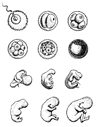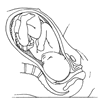Specialised reproductive systems provide maximum chance for fertilisation of the sex cells (gametes) as well as protection of the developing young to ensure continuity of the species through time.
AnatomyThe female reproductive organs are protected by the bones of the pelvis.
Ovulation
The gametes (sex cells) are produced in the ovaries. From the onset of
sexual maturity (puberty) when there is increased secretion of the female
sex hormone oestrogen, one egg cell (ovum) matures about every 28 days,
and is released into the oviduct (Fallopian tube). This is called ovulation.
 The
menstrual cycle
The
menstrual cycle
Hormones control the maturation of the egg cells (ovulation) in parallel
with the cyclic maturation of the uterus lining to ensure that if the
egg is fertilised the uterine wall will be ready to receive and nourish
it.
The contraceptive pill contains hormones which over-ride this normal cycle, preventing ovulation.
 Fertilisation
Fertilisation
If the ovum encounters a sperm cell in the oviduct, fertilisation can
occur forming the first cell of the new individual (zygote). Many sperm
will reach the ovum, but only one can penetrate the surface and fertilise
it.
 The
zygote then moves down into the womb (uterus) and embeds in the blood-rich
lining. The fertilised egg cell divides into two, four and eight cells,
and these cells continue to divide to make up the billions of cells in
the baby at birth.
The
zygote then moves down into the womb (uterus) and embeds in the blood-rich
lining. The fertilised egg cell divides into two, four and eight cells,
and these cells continue to divide to make up the billions of cells in
the baby at birth.
Hormones now produced prevent the breakdown of the uterus lining so menstruation (monthly period) no longer occurs
. |
 |
The embryo continues to grow and the cells differentiate into different specialised tissues, as the foetus develops.
 Placenta
Placenta
The placenta is an organ attached to the lining of the uterus where the
mother's blood vessels exchange nutrients and wastes with the blood of
the foetal circulatory system. The umbilical cord connects the placenta
to the baby, joining at the navel.
Birth (parturition)
At full term (gestation in humans is approximately 40 weeks from the last
menstrual period), the strong muscle walls of the uterus contract, pushing
the baby's head through the neck of the womb (cervix) and down the birth
canal (vagina).

|

|
 |
 The
umbilical cord is cut and tied by the doctor, and the baby's first cry
draws air into its lungs.
The
umbilical cord is cut and tied by the doctor, and the baby's first cry
draws air into its lungs.
The placenta is then delivered (afterbirth), with the remainder of the uterus lining being expelled over the next few days.
Milk production (lactation)
The mammary glands (breasts) first produce a clear liquid containing antibodies
(colostrum), and later produce milk to nourish the baby. The hormones
controlling breast feeding usually prevent further ovulation, ensuring
more attention for the baby and greater chance of survival as a consequence.
| Copyright owned by the State of Victoria (Department of Education and Early Childhood Development). Used with Permission. |


